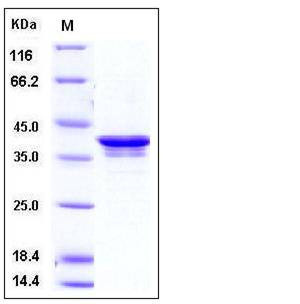Human PDK / PDZ binding kinase / TOPK Protein (His Tag)
CT84,HEL164,Nori-3,SPK,TOPK
- 100ug (NPP2385) Please inquiry
| Catalog Number | P10729-H08B |
|---|---|
| Organism Species | Human |
| Host | Baculovirus-Insect Cells |
| Synonyms | CT84,HEL164,Nori-3,SPK,TOPK |
| Molecular Weight | The recombinant human PBK consists of 333 amino acids and predicts a molecular mass of 37 kDa as estimated in SDS-PAGE under reducing conditions. |
| predicted N | Met |
| SDS-PAGE |  |
| Purity | > 95 % as determined by SDS-PAGE |
| Protein Construction | A DNA sequence encoding the full length of human PBK (NP_060962.2) (Met 1-Val 322) was fused with a polyhistidine tag at the C-terminus. |
| Bio-activity | No Kinase Activity |
| Research Area | Cancer |Cell cycle |Cell division |Cytokinesis |
| Formulation | Lyophilized from sterile PBS, pH 7.4 1. Normally 5 % - 8 % trehalose, mannitol and 0.01% Tween80 are added as protectants before lyophilization. Specific concentrations are included in the hardcopy of COA. |
| Background | PDZ binding kinase (PBK), also known as TOPK (T-LAK cell-originated protein kinase), is a serine/threonine kinase related to the dual specific mitogen-activated protein kinase kinase (MAPKK) family, and has all the characteristic protein kinase subdomains and a C-terminal PDZ-binding T/SXV motif. PBK is expressed in the testis restrictedly expressed in outer cell layer of seminiferous tubules, as well as placenta. PBK may be enrolled in the activation of lymphoid cells and support testicular functions, with a suggested role in the process of spermatogenesis.This mitotic kinase phosphorylates MAP kinase p38 and seems to be active in mitosis. When phosphorylated, PBK forms a protein-protein interaction with tumor suppressor p53 (TP53), leading to TP53 destabilization and attenuation of G2/M checkpoint during doxorubicin-induced DNA damage. The expression level of PBK is thus upregulated in a variety of neoplasms including hematological malignancies. |
| Reference |
